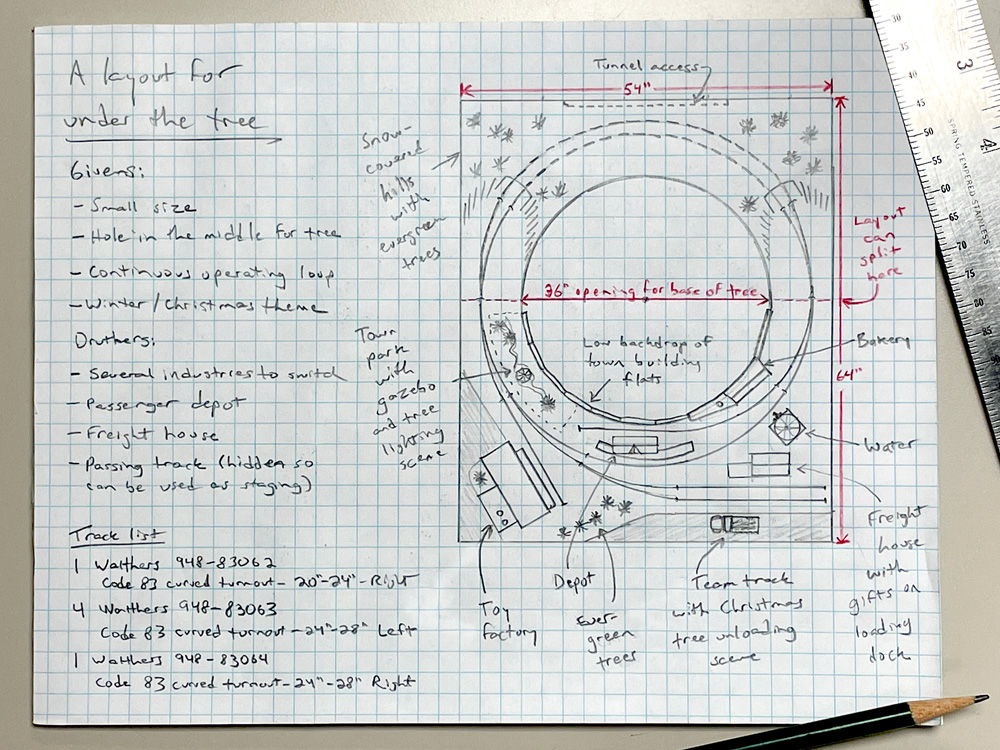
A lot of railroad modelers got their start in the hobby when they received a train set for Christmas. I’d bet that most of them woke up to find the train not in a box but running in circles under the tree. What dad could resist setting up the train “just to test it?” Arranging the track and turning the knob to start the train rolling became for these lucky kids as much a part of decorating the tree as hanging ornaments, blinking lights, and tinsel.
But after the initial thrill wears off, what fun is there in watching a train chase its tail all day? We didn’t want to just watch the train, we wanted to play with it. A lot of us feel the same way today. That’s why with this track plan for under the Christmas tree, I updated the old circle of track to turn it into a compact but working layout.
As you can see on my sketch, I started out with a list of “givens” and “druthers.” Coined by the dean of track planning, John Armstrong, these terms describe features and conditions that influence a plan’s design. Givens are inflexible – things like modeling scale, prototype, room size and shape, and the location of things like doors, windows, posts, and water heaters. Druthers are things you’d rather (or druther – get it?) have but are optional, like locale, era, favorite industries, and operating features like a wye, switchback, or branch line.
The givens for this track plan for under the Christmas tree were pretty obvious. It has to be on the small side, since the tree will likely be set up in a room that still has to serve as family living space. There has to be a hole in the middle for the base of the tree. The basic track configuration must be a loop, for that all important continuous operation. And to fit in with the festive holiday atmosphere, it has to have a wintery, Christmas-y theme.
My druthers covered turning this simple loop of track into a fun to operate layout. I wanted several industries to switch, which would mean working a number of turnouts into the loop. Curved turnouts would accomplish this most gracefully, so I looked at what Walthers had to offer. The WalthersTrack line includes a number of HO scale code 83 curved turnouts in convenient sizes, so I settled on those (which also settled the question of what scale to use). The Walthers turnouts come in two sizes: 20” and 24” radii, and 24” and 28”. If I planned my main line as a 24” radius circle, I could use these to branch off spurs both inside and outside the circle. So that circle was the first thing I drew. Using the same center point, I adjusted my compass and drew an 18” radius opening inside it for the base of the tree.
Since the back of the layout, and the back of the tree, would likely be up against a wall or a window, there shouldn’t be too much going on back there. I decided that was the perfect place for a passing track. Two 24”-28” curved turnouts lead into and out of it. I left the turnouts visible for reliability but hid the double track under a snow- and pine-covered hill so it could serve as staging. Sending one train into the tunnel and having a different one come out would reinforce the illusion that the tunnels lead to the outside world.
Now to the front of the layout, where the action would be. A depot where townspeople can greet relatives coming home for the holidays is a must for a track plan for under the Christmas tree, so I put that front and center. On the right side, at the points of the turnout that leads to the passing/staging track, I added a 20”-24” turnout leading to a house track behind the depot. It’s a little tight back there, so if I were actually building this, I might make the tree opening a bit smaller than 36” across to make room for town buildings and maybe a main street. But since I don’t know how big a tree is going to go in that opening, I left it as is and drew building flats to represent the town.
Now for some other spurs to work. If I’m going to keep this layout compact, I probably have room for at most two. If I start at the points of the passing track turnout on the left side like I did on the right, two 24”-28” curved turnouts fit nicely. One will lead to a short spur on the left, probably an industry. On the right there’s enough room to add another turnout to give me two parallel tracks – not much of a yard, but somewhere to store and sort cars.
Let’s pick some industries for those spurs. There’s extra room on the approach to the house track inside the loop. Let’s add on to one of the building flats and add another industry. Since this is a track plan for under the Christmas tree, let’s make it a bakery to provide all those Christmas cookies, pies, dinner rolls, and breakfast pastries. This industry would receive covered hoppers of flour and sugar, but it probably wouldn’t ship by rail.
The single spur on the left has room for a good-sized building footprint, which is good because we want it to be big enough to need rail service, but not too tall to fit under low-hanging tree branches. Let’s make it a toy factory. Depending on the era you want to model and what kind of toys you imagine it makes, it could receive wood in boxcars or covered hoppers of plastic pellets. (Add some silos to store them if the latter is the case.) Finished goods would ship out in boxcars. With just two industries on the layout, we already have a nice variety of rolling stock.
To expand our operating possibilities further, let’s turn the two tracks at the front into universal industries, able to ship and receive almost any kind of lading imaginable. A freight house on the rear track will ship and receive less-than-carload-lot (LCL) freight, so let’s add some boxes of gifts to its loading dock.
If we pave the area in front of the other track, it becomes a team track. Add a stakebed truck with bundled Christmas trees for an unloading scene. (Busch has an HO scale Christmas tree lot scene that includes bundled trees (part no. 1182), but you could make your own fairly easily from bumpy chenille or thick green yarn wrapped with black or white thread.)
Other cars that could be delivered to our team track could include a coal hopper, reefers of Christmas hams and turkeys, maybe even a flatcar carrying Santa’s sleigh and a stockcar of reindeer! It’s a Christmas display, why not be fanciful?
Now let’s wrap it up with some scenery and details. A snowy landscape is a must (check out Kathy Millatt’s video, “Let’s Make a Scene” episode 9, for tips on winter scenery). Snow-covered conifer trees will add to the Christmas atmosphere. Some sledding figures on the hill would be fun, too.
There’s room inside the loop on the left side of the depot; why not make it a park scene with a tree-lighting ceremony? Noch offers a snow-covered tree illuminated with yellow LEDs (item no. 22130) that would make a great centerpiece. Add a children’s choir from Faller (item no. 151648) and some passersby in winter clothing, and you’ve got an eye-catching holiday model train display that’s also fun to operate.






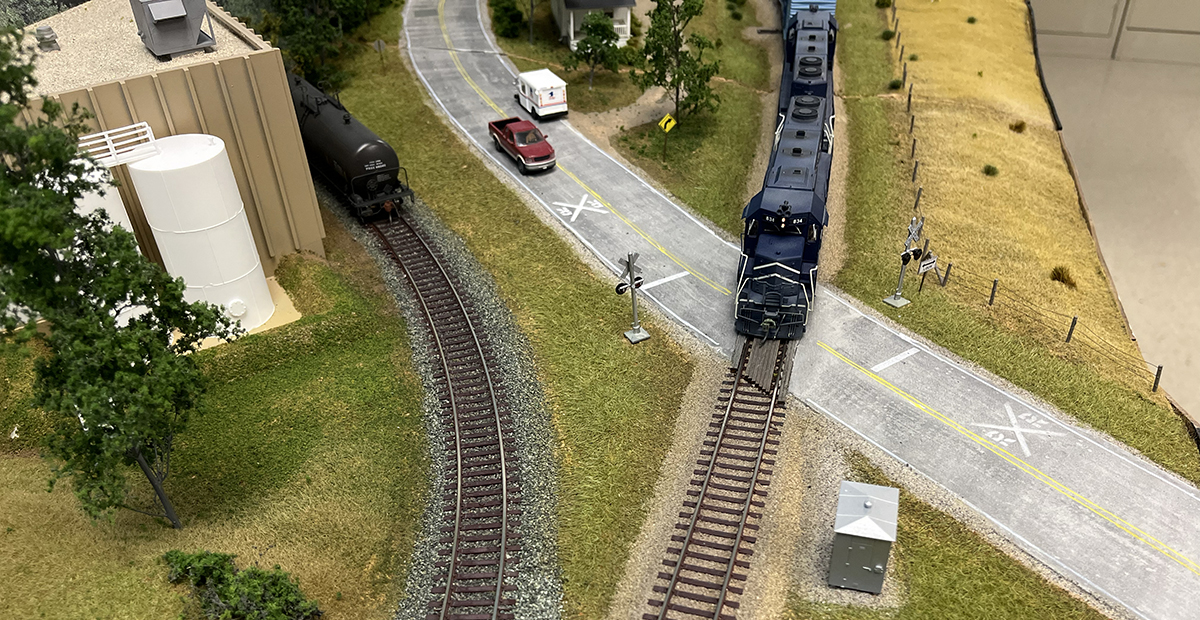
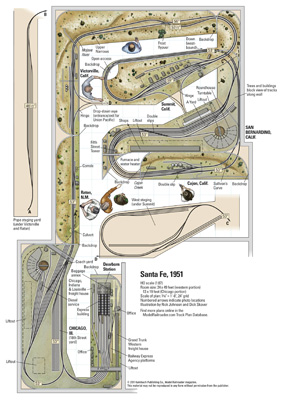
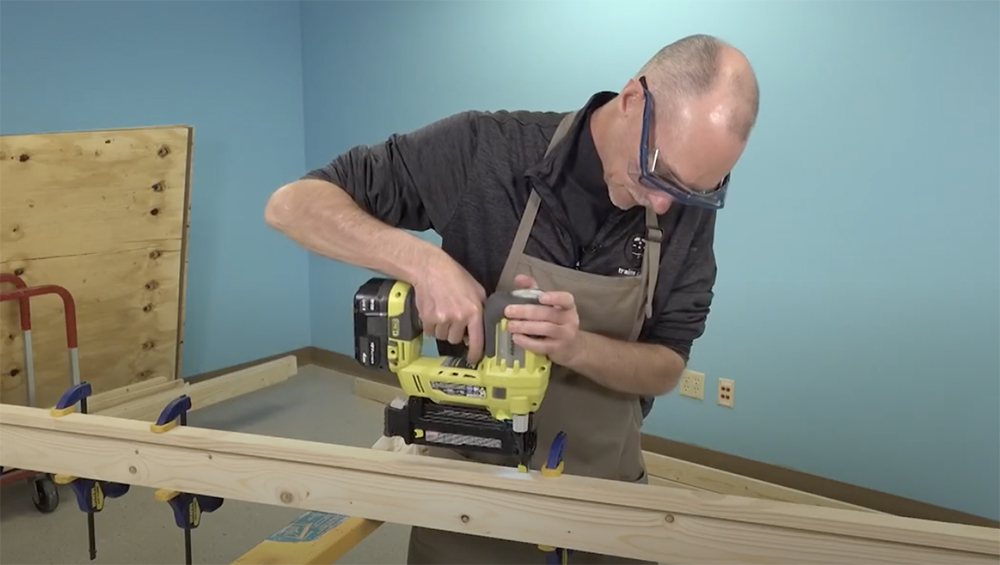
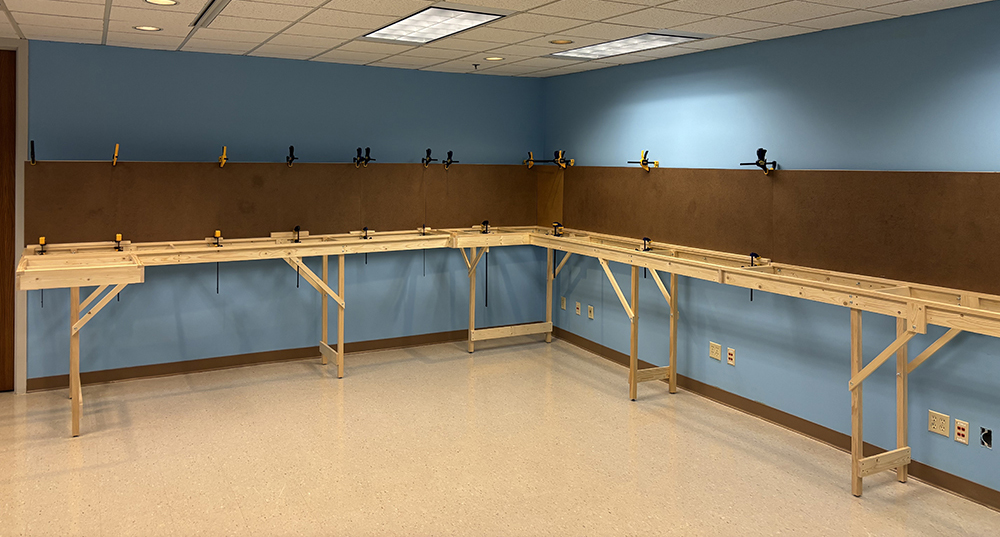




Is this plan assuming DC or DCC ? Obviously you could use either, but wondering if you had one or the other in mind ?
This is a great article, Steve. Thanks for putting it together. Some thoughts on construction:
1. Slice the layout in half horizontally. This will allow for easier storage and transportation, as well as allow the layout to be built from one 4×8 sheet.
2. Support the layout on a frame of 1×3 or 1×4. This will allow the two halves to be joined more reliably and keep dust from the floor away while still allowing clearance of low-hanging tree branches. This will also permit the use of low-profile switch machines, if desired.
To add a touch of nostalgia, it would be nice to use steam locomotives, but since the layout is likely to be handled by little hands, it will be more practical to use small diesels that can operate in both directions.
Thanks again.